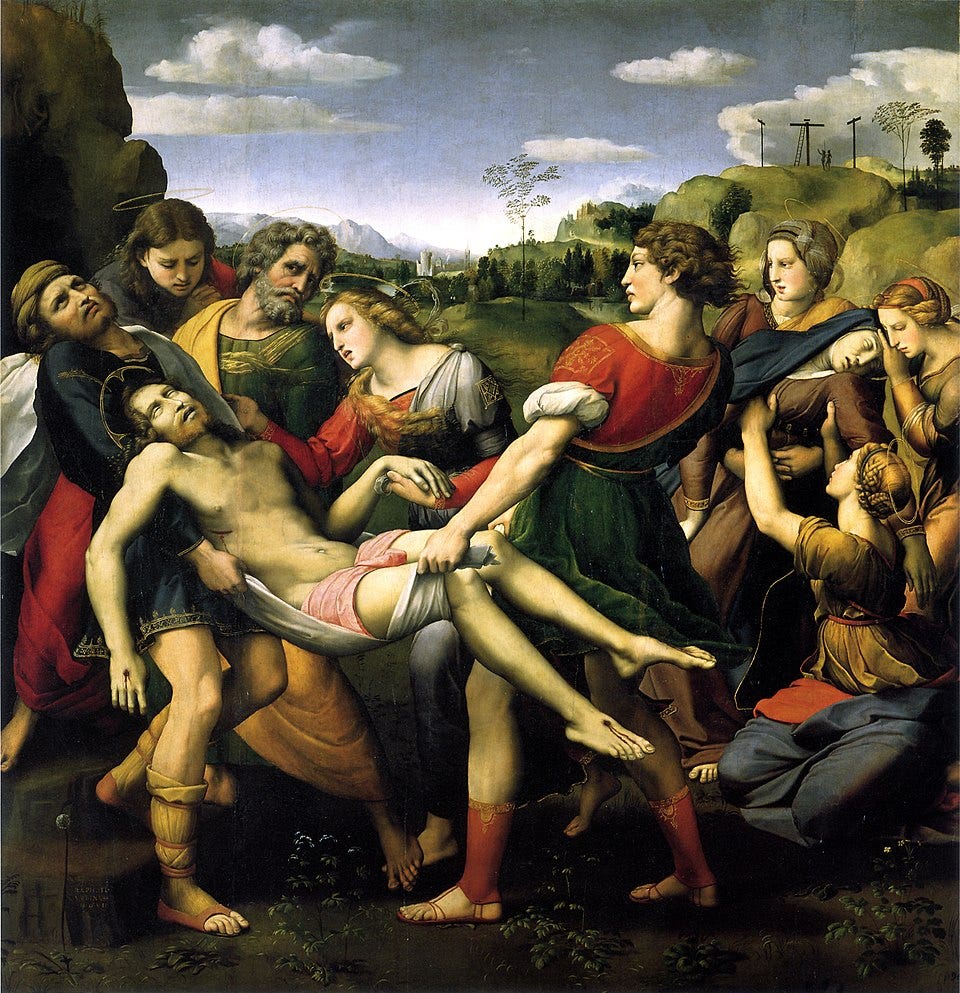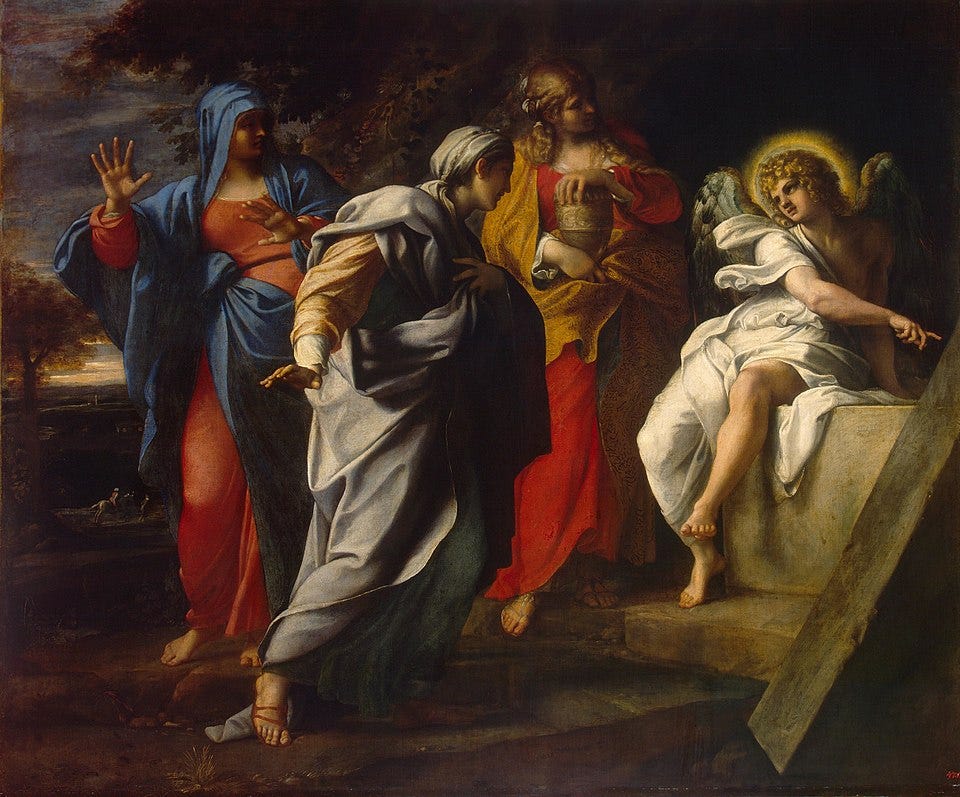Today is the Feast Day of Mary Magdalene
How Faithful Waiting Became the First Proclamation of the Gospel
She Kept Looking: The Unshakeable Hope of St. Mary Magdalene
Today the Church celebrates the feast of a remarkable witness, St. Mary Magdalene. When we think of her, we often recall the account from St. Luke’s Gospel that Jesus had cast “seven demons” out of her (Luke 8:2). We can only imagine the interior chaos and suffering she must have endured. Her life, before meeting Jesus, was one of fractured identity and torment. Yet, in her encounter with Christ, she was not just healed, but made whole. The madness of her affliction was replaced by a serene and focused contemplation of the One who saved her. This encounter planted deep within her soul the virtues of faith and hope, which would become the anchors of her life.
Her story becomes a quiet guide for our own. In every life, there are moments of trial, of confusion, where we feel fragmented or lost. We might ask ourselves, as we are invited to do in every difficulty: What act of faith is God inviting me to make here? What small gesture of hope can I live out today? For Mary, her entire life after her healing became an answer to this question.
The Letter to the Hebrews, in its great chapter on faith, tells us that “faith is the assurance of things hoped for, the conviction of things not seen” (Hebrews 11:1). Though she is not named in that list of Old Testament heroes, Mary Magdalene lives out this very definition in the drama of the Passion and Resurrection.
Think of her journey. She stood at the foot of the Cross. When nearly all the others fled in fear and confusion, she remained. What was stirring in her heart that kept her there? Perhaps it was the vivid memory of her own salvation. The One who had brought her from darkness into light was now shrouded in the deepest darkness of suffering. Love held her there. She didn't run from the trial; she entered into it, accompanying her Lord with the quiet fidelity of a grateful heart.
She followed Joseph of Arimathea and saw where they laid Jesus’ body. She watched as the great stone was rolled into place, sealing the tomb. Imagine the finality of that moment. For so many, this was the end. The hope they had placed in Jesus was now buried behind a rock. We can almost feel their sorrow as they scattered, perhaps retreating back to the monotony of their former lives, their hopes dashed. Did they give up? Did they believe it was all over? Their absence from the tomb that early morning suggests a hope that had faltered.
But not Mary’s.
She went back. In the pre-dawn darkness, while the world was still asleep, her hope was awake and searching. The Gospels tell us she found the stone rolled away and the tomb empty. Here she faced a new trial: not just grief, but bewilderment. Her Lord was gone. Even in this, her faith did not collapse. St. John tells us that after Peter and the other disciple saw the empty tomb and “went back to their homes,” that “Mary stood weeping outside the tomb” (John 20:10-11).
She stayed. She kept looking.
This simple act of refusing to leave the place of loss is a powerful expression of faith. Embedded in her tears and in her searching gaze was the unshakable hope that her relationship with the Lord was not over. She did not understand what had happened, but she would not abandon the search for Him. Her heart was asking the only question that mattered: “Where have they taken my Lord?” (John 20:13). It was not a question of despair, but a question of love that refused to let go.
And it is precisely in this moment of faithful looking that Christ comes to her. He does not appear to the ones who went home, but to the one who stayed. He meets her in her search. And how does he break through her grief? He calls her by name: “Mary” (John 20:16).
In that single word, everything is restored. The Shepherd has found His lost sheep, and the sound of His voice brings immediate recognition, healing, and joy. The chaos of her grief is replaced by the peace of His presence. Her searching has led her to the greatest discovery in human history.
From this encounter flows the first apostolic commission of the New Covenant. Jesus tells her, “Go to my brethren and say to them, ‘I am ascending to my Father and your Father, to my God and your God’” (John 20:17). She looked, she heard, and she went and told. This is why the great St. Thomas Aquinas gives her the beautiful title, Apostola Apostolorum—the Apostle to the Apostles. She was the first person sent to proclaim the Resurrection, the very heart of the Gospel, to those who would be the pillars of the Church.
What does Mary’s journey ask of us today? When we face our own empty tombs. Maybe its the loss of a loved one, or a crisis of faith, or an intense period of spiritual dryness, or a deep confusion about where God is in our lives. What is our response? Do we walk away, concluding that it is over and return to what is familiar?
Or do we, like Mary, have the courage to stay? Can we remain in the place of our uncertainty, and simply keep looking for the Lord? Can we allow our hearts to continue asking for Him, even through our tears?
Mary Magdalene teaches us that our faithful searching, even when we feel lost, is itself a prayer that pleases God. It is an act of hope that clears a space in our hearts for Him to enter. And if we persevere, if we keep looking, we too can trust that He will come to us, speak our name, and turn our sorrow into a mission of joy.
Let us ask St. Mary Magdalene for her intercession, that we might receive the grace to wait, to search, and to listen for the voice of the Risen Lord in our own lives.
© 2025, Mission Surrender, LLC. All Rights Reserved.





